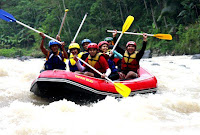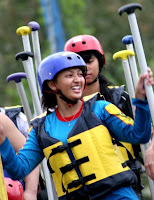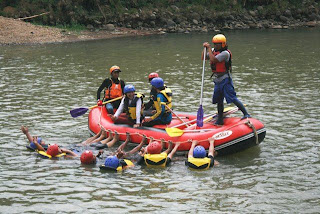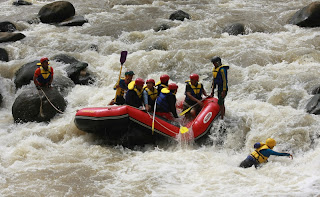Rafting at this time begin again become attracted many sporting activities. Most want to try to test the adrenalin in the rapids with a safe way to relieve fatigue than when it has undergone during the six days of work time. But before embarking on her Rafting or Rafting, try the following tips to know 7.
1. Find out about river
Before going to the rafting site, find out first information about the river you will pass. Information sought can be swift current, the length of the river to be impassable, types of rocks and zones - zones of extremes. This will help you to find out the terrain to be encountered.
2. Eat 2-3 hours sebelumber Rafting
Another thing to consider before air Rafting is filling the stomach. Rafting is a sport that will spend a lot of energy. So, if you do not want to run out of steam, eat first. But remember, do not eat right before you start your rafting because it can cause sickness - nausea and even vomiting. Eat 2 or 3 hours before starting.
3. Do Warming
During Rafting, there will be a lot of things happen. You may be required to jump or swim arrived - arrived. To avoid muscle injuries, do warm up 10-15 minutes before starting. It's important to flex its muscles.
4. Note the existing facilities
In addition to heating, you should pay attention to the correct fittings are used. Examples of standard equipment is that you should wear a helmet and life jacket. Make sure the helmet is also installed properly. Do not get off when you wade through the swift river.
5. Listen to the instructions correctly
Well, here's the most important, listen to instructions before rafting guides. Consider this - what should be done and should not be done. Do not get confused when you are in the middle - the middle of a fast-flowing river.
6. Don't panic when the boat overturned
Events that most often occurs when air Rafting is used inflatable boats upside down. If you experience this, do not trigger panic. Calm down for a float that will make you float charged. In addition, the attitude of panic issued can actually make your drifting.
7. Use a reliable guide
Each activity Rafting usually use the package provided by certain agents. Well, make sure the agent used is a professional agent and you already know the quality of work. If there are local residents that offer Rafting package, you should still use the official packages or agent who has been entrusted. This relates to the comfort and safety during activities Rafting takes place.
Source: http://www.belantaraindonesia.org/2012/02/7-tips-sebelum-memulai-arung-jeram.html
Read More...>>> → 7 Tips Before You Begin Rafting
1. Find out about river
Before going to the rafting site, find out first information about the river you will pass. Information sought can be swift current, the length of the river to be impassable, types of rocks and zones - zones of extremes. This will help you to find out the terrain to be encountered.
2. Eat 2-3 hours sebelumber Rafting
Another thing to consider before air Rafting is filling the stomach. Rafting is a sport that will spend a lot of energy. So, if you do not want to run out of steam, eat first. But remember, do not eat right before you start your rafting because it can cause sickness - nausea and even vomiting. Eat 2 or 3 hours before starting.
3. Do Warming
During Rafting, there will be a lot of things happen. You may be required to jump or swim arrived - arrived. To avoid muscle injuries, do warm up 10-15 minutes before starting. It's important to flex its muscles.
4. Note the existing facilities
In addition to heating, you should pay attention to the correct fittings are used. Examples of standard equipment is that you should wear a helmet and life jacket. Make sure the helmet is also installed properly. Do not get off when you wade through the swift river.
5. Listen to the instructions correctly
Well, here's the most important, listen to instructions before rafting guides. Consider this - what should be done and should not be done. Do not get confused when you are in the middle - the middle of a fast-flowing river.
6. Don't panic when the boat overturned
Events that most often occurs when air Rafting is used inflatable boats upside down. If you experience this, do not trigger panic. Calm down for a float that will make you float charged. In addition, the attitude of panic issued can actually make your drifting.
7. Use a reliable guide
Each activity Rafting usually use the package provided by certain agents. Well, make sure the agent used is a professional agent and you already know the quality of work. If there are local residents that offer Rafting package, you should still use the official packages or agent who has been entrusted. This relates to the comfort and safety during activities Rafting takes place.
Source: http://www.belantaraindonesia.org/2012/02/7-tips-sebelum-memulai-arung-jeram.html




























